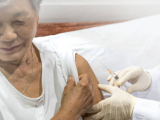Feb 20, 2007 (CIDRAP News) – Because of changes in the influenza viruses now in circulation, the World Health Organization (WHO) has recommended changing one of the three viral strains to be used in flu vaccines in the Northern Hemisphere next fall and winter.
The WHO is recommending changing the influenza A/H1N1 strain in the vaccine for the first time since the 2000-01 season. The agency recommends a Solomon Islands strain of H1N1, replacing a New Caledonia strain. The New Caledonia strain of H1N1 had been recommended for the previous 7 years.
The other two recommended strains remain the same as last year. They are a Wisconsin strain of influenza A/H3N2 and a Malaysia strain of influenza B. The WHO had changed the H3N2 strain the past 3 years and changed the B strain last year.
Each February the WHO assesses the flu virus strains in circulation before picking the strains for the next Northern Hemisphere flu season. It takes about 6 months for vaccine manufacturers to grow the viruses in chicken eggs and formulate them into trivalent (three-strain) vaccines. In many years the WHO picks one new strain and some years selects two, as was the case a year ago.
The WHO report on its recommendations, published last week, says H1N1 viruses have predominated in the United States so far this season (September to January), while H3N2 viruses have been more prominent in Canada and Europe. Type B viruses have been circulating at low levels in most countries.
Analysis of the circulating H1N1 viruses has shown that many "were antigenically similar to the current reference virus, A/New Caledonia/20/99, but an increasing proportion of recent viruses was more closely related to A/Solomon Islands/3/2006," the WHO said. Tests in ferrets immunized with the current vaccine showed that the Solomon Islands strain generated a lower antibody response than the New Caledonia strain did, which prompted the decision to recommend using the Solomon Islands variant.
Concerning the H3N2 viruses in circulation, the WHO said tests have shown many samples were similar to the current vaccine virus, called A/Wisconsin/67/2005, but a growing proportion of recent isolates have varied. However, the differences have not emerged clearly enough to warrant changing the recommended vaccine strain.
"While there was genetic variation, the absence of a sufficiently well characterized antigenically variant group including the lack of corresponding egg isolates precluded the selection of a new vaccine candidate in time for the 2007-2008 influenza season," the report said.
In other comments, the WHO report says that H3N2 viruses worldwide continue to show high resistance to the two older antiviral drugs used for flu—amantadine and rimantadine. Some H1N1 viruses also are resistant to the drugs, but the proportion varies by country. The US Centers for Disease Control and Prevention (CDC) has been recommending against using the two drugs in seasonal flu cases since January 2006.
The US Food and Drug Administration and the CDC normally issue their own recommendations about strains for flu vaccines in the United States shortly after the WHO and typically match the WHO advice.
Jennifer Armstrong, a spokeswoman for GlaxoSmithKline, a flu vaccine manufacturer, said the company waits for the CDC recommendations before starting the process of making vaccines for the US market.
See also:
Full WHO report on strain selection
http://www.who.int/influenza/vaccines/20078anorthreport.pdf
WHO page with list of past vaccine strains
http://www.who.int/influenza/vaccines/vaccinerecommendations1/en/index.html
Mar 1, 2006, CIDRAP News story "Two new strains to be used in 2006-07 flu vaccine"
http://www.cidrap.umn.edu/cidrap/content/influenza/general/news/mar0106vaccine.html

















